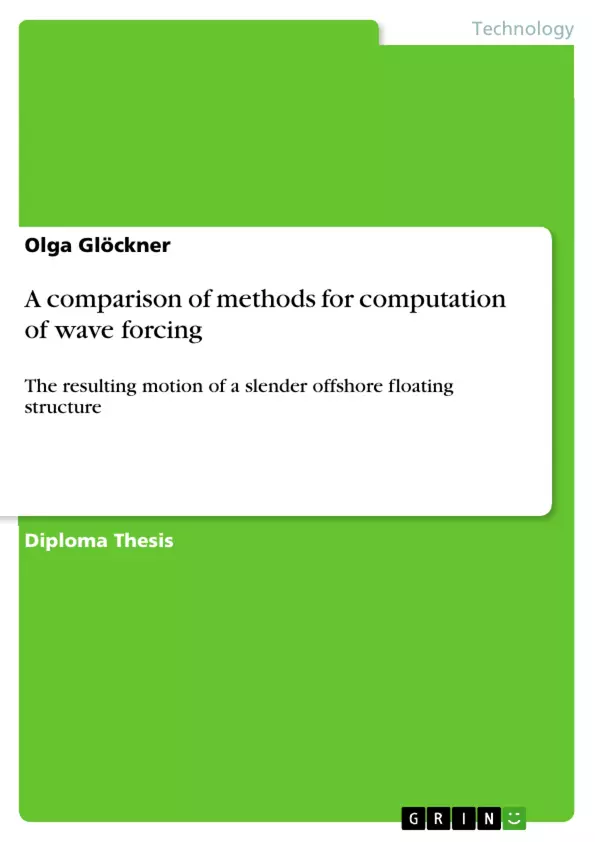Unlike fossil fuels (for example oil, coal and natural gas), wind energy is a renewable energy resource. Since winds at sea are stronger and more consistent than onshore winds, the demand for offshore wind turbines has increased over the last years.
As energy can be produced more efficient in deeper water, several floating offshore wind turbine constructions, such as the OC3 Hywind spar-buoy, have been proposed. The design of floating wind turbines depends on the simulation of the system behavior caused by exciting forces. This thesis deals with the comparison between different methods for calculating wave forces and resulting platform motions of a floating offshore wind turbine.
On the one hand, wave exciting loads computed with Morison’s equation are compared to the hydrodynamic forces simulated by the open source code FAST on the basis of the diffraction theory. On the other hand, response motions of the floating structure are simulated by the commercial offshore software SESAM in the frequency domain and compared with the motions calculated by FAST in the time domain.
Inhaltsverzeichnis (Table of Contents)
- INTRODUCTION
- Background
- Outline
- STATE OF THE ART.
- Regular Waves
- Description....
- Linear Wave Theory
- Basic equations.
- Boundary conditions…..\n
- Wave kinematics and pressure.
- Stretched Airy Theory
- Irregular Waves.....
- Description in the Frequency Domain.
- Hydrostatics of Floating Structures
- Static Stability..
- Hydrodynamics of Rigid Bodies..
- Coordinate Systems.
- Diffraction Theory.
- Hydrostatic and Dynamic Loads on Floating Structures.
- Fundamentals..
- Forces and Moments...
- Radiation and Diffraction Loads
- Wave Excitation Loads...
- Hydrostatic Loads.......
- Floating Structures in Waves.
- Coupled Equations of Motion....
- Motions in Regular Waves
- Response amplitude operator..
- Motions in Irregular Waves..
- Regular Waves
- FLOATING WIND TURBINE MODEL..
- OC3 Hywind..
- Tower and Platform Structural Properties
- Floating Platform Hydrodynamic Properties...
- Mooring System Properties
- OC3 Hywind..
- MATLAB....
- Morison Forces.
- Morison Forces due to Regular Waves..
- Morison forces due to Irregular Waves.
- Morison Forces.
- SESAM.
- GeniE
- The Modelling Process.
- HydroD.....
- Coordinate System.........
- Panel Model.
- Mass Model
- Analysis Preparation...
- Wadam
- Global Response Analysis in Wadam..
- Postresp.......
- GeniE
- FAST
- Basic Assumptions...........
- Hydrodynamic Module (HydroDyn).
- Diffraction Problem.
- Radiation Problem
- Hydrodynamic Results...
- Regular Waves....
- Irregular Waves
- COMPARISONS OF THE METHODS....
- Comparison of Excitation Loads
- Comparison of Response Motions..
- SUMMARY AND CONCLUSION.
- REFERENCES
Zielsetzung und Themenschwerpunkte (Objectives and Key Themes)
This thesis aims to compare different methods for calculating wave forces and resulting platform motions of a floating offshore wind turbine. The focus is on examining the accuracy and limitations of these methods in simulating the behavior of such structures.
- Comparison of wave force calculation methods
- Evaluation of platform motion simulation techniques
- Analysis of the OC3 Hywind floating wind turbine model
- Investigation of hydrodynamic and structural interactions
- Assessment of the influence of wave characteristics on system behavior
Zusammenfassung der Kapitel (Chapter Summaries)
The introduction provides background information on the increasing demand for offshore wind energy, specifically focusing on floating wind turbine constructions. The chapter highlights the importance of accurate simulation of system behavior caused by exciting forces, setting the stage for the thesis's focus on comparing different calculation methods.
Chapter 2 reviews the relevant state of the art regarding wave theory, hydrostatics, hydrodynamics, and the dynamic behavior of floating structures in waves. It introduces key concepts and equations that underpin the later comparisons of different methods.
Chapter 3 delves into the specific model of a floating wind turbine, the OC3 Hywind, describing its structural properties, hydrodynamic characteristics, and mooring system.
Chapter 4 explores the use of MATLAB for calculating Morison forces, a method commonly used for estimating wave forces on slender structures. It examines the application of Morison's equation for both regular and irregular wave conditions.
Chapter 5 introduces several commercial software programs used in offshore engineering, such as SESAM, GeniE, HydroD, Wadam, and Postresp. This chapter outlines the modeling process, software capabilities, and how these tools contribute to the overall analysis.
Chapter 6 focuses on the FAST software program, a powerful tool for simulating the dynamic response of floating structures. This chapter discusses the underlying assumptions of FAST, particularly its hydrodynamic module (HydroDyn) which utilizes diffraction and radiation theory to model wave-structure interactions.
Chapter 7 presents a comprehensive comparison of the different methods for calculating wave forces and simulating platform motions, drawing on the previous chapters' discussions of individual approaches. The results of these comparisons provide insights into the strengths and limitations of each method.
Schlüsselwörter (Keywords)
The central keywords and focus topics of this thesis encompass floating offshore wind turbines, wave forces, platform motions, hydrodynamic analysis, and the OC3 Hywind model. These keywords reflect the research focus on accurately simulating the complex interactions between waves and floating structures in the context of renewable energy generation.
- Quote paper
- Olga Glöckner (Author), 2014, A comparison of methods for computation of wave forcing, Munich, GRIN Verlag, https://www.grin.com/document/425816



